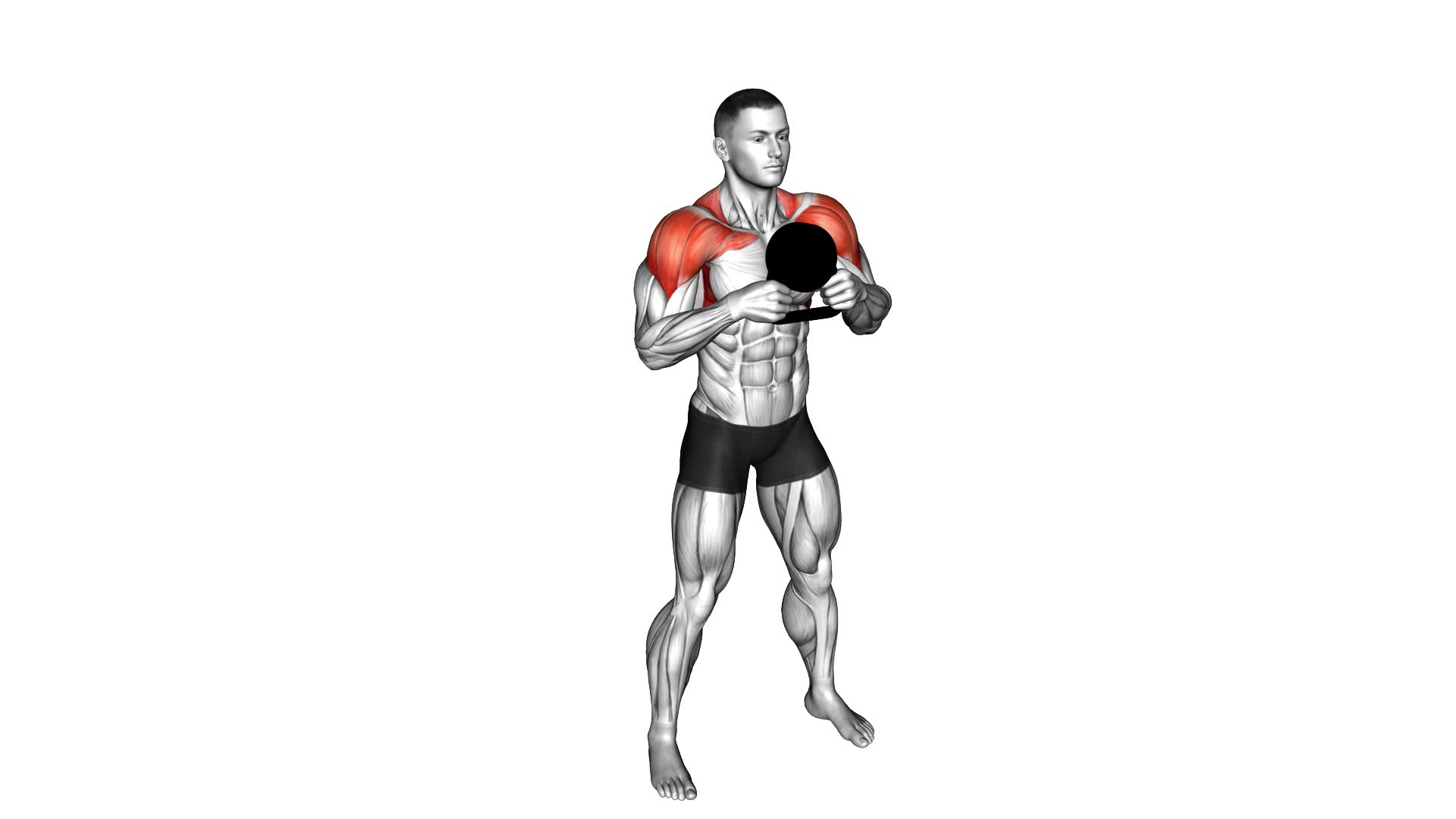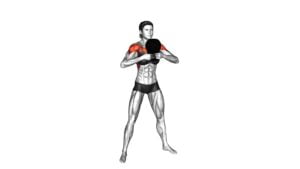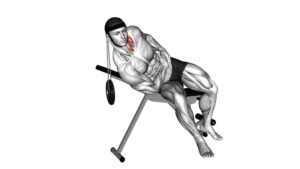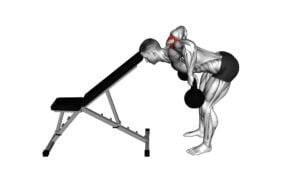Kettlebell Around Head Rotation – Video Exercise Guide & Tips

Discover how to properly perform the Kettlebell Around Head Rotation exercise in this video guide.
Watch This Exercise Video
You'll learn the benefits, proper form, and the equipment needed to master this exercise.
Avoid common mistakes and get tips to enhance your technique.
So grab your kettlebell and get ready to strengthen your core and improve your stability with this effective rotational exercise.
Let's get started!
Key Takeaways
- Kettlebell around head rotation improves flexibility in the shoulder and upper back muscles.
- It provides variations for all fitness levels and increases mobility and range of motion.
- This exercise is beneficial for individuals with tight shoulders or limited flexibility.
- Gradually increasing the weight challenges the muscles and is crucial for stability, balance, and injury prevention.
Benefits of Kettlebell Around Head Rotation
Discover the numerous benefits you can achieve by incorporating kettlebell around head rotations into your workout routine. This exercise not only helps in improving flexibility but also provides variations for all fitness levels.
One of the key advantages of kettlebell around head rotations is the improvement in flexibility it offers. As you rotate the kettlebell around your head, your shoulder and upper back muscles are engaged, leading to increased mobility and range of motion in these areas. This exercise can be especially beneficial for individuals who've tight shoulders or limited flexibility.
Another benefit of kettlebell around head rotations is the ability to customize the exercise to suit different fitness levels. Beginners can start with a lighter kettlebell and focus on mastering the technique and form before progressing to heavier weights. As you become more comfortable, you can gradually increase the weight of the kettlebell to further challenge your muscles.
Furthermore, kettlebell around head rotations allow for variations that cater to individuals with different fitness levels. You can perform this exercise in standing or seated positions, depending on your preference and comfort level. Additionally, you can choose to rotate the kettlebell in one direction or alternate between clockwise and counterclockwise rotations to target different muscle groups.
Incorporating kettlebell around head rotations into your workout routine can provide significant benefits such as improved flexibility and variations for all fitness levels. Whether you're a beginner or an experienced fitness enthusiast, this exercise can be adapted to suit your needs and help you achieve your fitness goals.
Proper Form and Technique
To perform the kettlebell around head rotation exercise with proper form and technique, there are a few key points to keep in mind.
First, engaging your core is crucial to maintain stability and protect your lower back.
Second, it's important to avoid straining your shoulders by keeping them relaxed and maintaining proper alignment throughout the movement.
Lastly, practicing proper breathing techniques, such as exhaling on the exertion and inhaling during the relaxation phase, can help enhance stability and control during the exercise.
Core Engagement Importance
Engage your core muscles by maintaining proper form and technique during the kettlebell around head rotation exercise.
Core activation is crucial for stability and balance, and it helps to prevent injuries.
To engage your core, start by standing with your feet shoulder-width apart and your knees slightly bent. Keep your back straight and your shoulders relaxed.
As you rotate the kettlebell around your head, focus on tightening your abdominal muscles and drawing your navel towards your spine. This will help to stabilize your torso and protect your lower back.
Throughout the exercise, remember to breathe steadily and maintain control over the movement.
Avoiding Shoulder Strain
Maintain proper form and technique to avoid shoulder strain during the kettlebell around head rotation exercise. To protect your shoulders and ensure a safe and effective workout, follow these tips:
- Warm up your shoulders with dynamic stretches and mobility exercises, such as arm circles and shoulder rolls.
- Keep your shoulders relaxed and down throughout the entire movement.
- Engage your core muscles to provide stability and support for your shoulders.
- Avoid shrugging your shoulders or tensing your neck during the exercise.
- Start with a lighter kettlebell and gradually increase the weight as you build strength and improve your shoulder mobility.
By implementing these techniques, you can minimize the risk of shoulder strain and maximize the benefits of the kettlebell around head rotation exercise.
Remember to always listen to your body and stop if you experience any pain or discomfort.
Breathing Techniques for Stability
Keep your breathing steady and controlled to maintain stability and support for your shoulders during the kettlebell around head rotation exercise.
Proper breathing techniques can greatly improve your stability and overall performance during this exercise.
As you begin the movement, inhale deeply through your nose, filling your diaphragm with air.
As you rotate the kettlebell around your head, exhale slowly and steadily through your mouth.
This controlled exhalation helps engage your core muscles and stabilize your body. It also allows you to maintain proper form and technique throughout the exercise.
Remember to keep your breaths consistent and rhythmic, matching the pace of your rotations.
Equipment Needed for the Exercise
To perform the Kettlebell Around Head Rotation exercise, you'll need a kettlebell. Here are some important equipment details to keep in mind before you get started:
- Kettlebell: A kettlebell is the main equipment required for this exercise. Make sure you choose one that's suitable for your fitness level and strength. The weight of the kettlebell will depend on your experience and strength. It's recommended to start with a lighter weight and gradually increase as you become more comfortable with the exercise.
- Proper Hand Grip: When using the kettlebell, it's crucial to have a secure and comfortable grip. Ensure that your hands are fully wrapped around the handle, with your fingers pointing towards your body. This will help you maintain control and stability throughout the exercise.
- Comfortable Clothing: Wearing comfortable clothing is essential for any exercise routine. Opt for breathable and flexible attire that allows you to move freely. This will help you perform the Kettlebell Around Head Rotation exercise without any restrictions or discomfort.
- Stable Surface: Find a stable and non-slippery surface to perform this exercise. This will ensure your safety and prevent any accidental slips or falls during the rotational movements.
- Open Space: It's important to have enough space around you to perform the exercise smoothly. Clear the area of any obstacles or obstructions to avoid any accidents or injuries.
Step-by-Step Guide to Perform Kettlebell Around Head Rotation
To perform the Kettlebell Around Head Rotation exercise, follow these steps:
- Start by holding the kettlebell with both hands in front of your chest.
- Stand with your feet shoulder-width apart and engage your core for stability.
- This exercise is great for improving shoulder mobility and strengthening your core.
Begin the exercise:
- Press the kettlebell overhead, fully extending your arms.
- Keep your elbows locked and your wrists straight.
- Slowly start to rotate the kettlebell around your head in a circular motion.
- Maintain control and stability by engaging your core.
- Keep your shoulders relaxed and avoid any jerky movements.
Continue the exercise:
- Rotate the kettlebell around your head for a set number of repetitions or for a specific amount of time.
- Maintain proper form and control throughout the exercise.
- Focus on your breathing and stay mindful of any tension or strain in your shoulders or neck.
Complete the exercise:
- Once you have completed the desired number of rotations, carefully lower the kettlebell back to the starting position in front of your chest.
- Transition smoothly into the subsequent section about common mistakes to avoid to ensure you get the most out of this exercise and prevent any potential injuries.
Common Mistakes to Avoid
When performing the kettlebell around head rotation, it's important to pay attention to proper form and technique to avoid potential injuries.
To help you avoid common mistakes, let's discuss two key points.
First, make sure to keep your core engaged throughout the movement to maintain stability and control.
Second, be mindful of the weight of the kettlebell and start with a lighter one until you feel comfortable and confident with the exercise.
Proper Form Demonstration
By following proper form during the kettlebell around head rotation exercise, you can avoid common mistakes and maximize the effectiveness of the movement. Here are some important tips to ensure you're performing the exercise correctly:
- Maintain a tight grip on the kettlebell throughout the entire movement.
- Keep your core engaged and your back straight to prevent any strain or injury.
- Avoid swinging the kettlebell too forcefully, as this can lead to loss of control and potential accidents.
- Keep your elbows locked in place and focus on using your shoulders and upper body to rotate the kettlebell around your head.
- Always start with a lighter weight kettlebell and gradually increase the intensity as you become more comfortable with the exercise.
Following these guidelines won't only help you avoid common mistakes but also reduce the risk of injury during the kettlebell around head rotation exercise.
Injury Prevention Tips
Avoiding common mistakes is crucial to preventing injuries during the kettlebell around head rotation exercise. To ensure your safety, it's important to warm up properly before starting the exercise.
Warm up exercises help to increase blood flow, loosen up your muscles, and prepare your body for the workout ahead. Begin with some light cardio, such as jogging or jumping jacks, for about 5 minutes. This will raise your heart rate and warm up your entire body.
Next, perform dynamic stretches that focus on the muscles you'll be using during the kettlebell exercise, such as shoulder circles and neck rotations. These stretches help to improve flexibility and reduce the risk of strains or pulls.
Tips to Enhance Your Kettlebell Around Head Rotation
To enhance your kettlebell around head rotation, focus on maintaining a strong grip throughout the exercise. This will help you maintain control and stability as you move the kettlebell in a circular motion around your head.
In addition to a strong grip, there are several other tips that can help you improve your kettlebell around head rotation:
- Engage your core: By activating your core muscles, you can provide a stable base for your upper body to move the kettlebell. This will also help improve your balance and coordination during the exercise.
- Keep your shoulders relaxed: Tension in the shoulders can limit your range of motion and hinder the fluidity of the movement. Relax your shoulders and focus on maintaining a smooth and controlled rotation.
- Enhance flexibility: Having good flexibility in your shoulders and upper back will allow for a greater range of motion during the exercise. Incorporating stretching and mobility exercises specific to these areas can help improve your flexibility over time.
- Gradually increase weight: Start with a lighter kettlebell and gradually increase the weight as your strength and technique improve. This will help you progress safely and avoid strain or injury.
- Practice proper form: Pay attention to your body alignment and technique. Proper form is crucial for maximizing the benefits of the exercise and preventing injury.
Frequently Asked Questions
How Long Should I Perform the Kettlebell Around Head Rotation Exercise For?
To get the most out of the kettlebell around head rotation exercise, it's important to know how long to perform it for. The duration of this exercise depends on your fitness level and goals. Generally, aim for 10-15 repetitions on each side.
This exercise offers numerous benefits such as improving shoulder mobility, core stability, and upper body strength. Remember to maintain proper form throughout, engaging your core and keeping your shoulders relaxed.
Can I Do the Kettlebell Around Head Rotation Exercise if I Have a Shoulder Injury?
If you have a shoulder injury, it's important to be cautious when doing the kettlebell around head rotation exercise. While it can be a challenging and effective exercise, it may not be suitable for everyone with a shoulder injury.
Instead, consider alternative exercises that are more shoulder-friendly, such as lateral raises or front raises with dumbbells. These exercises can help strengthen your shoulders without putting too much strain on the injured area.
Always consult with a healthcare professional before starting any new exercise routine.
What Are Some Alternative Exercises That Target Similar Muscles as the Kettlebell Around Head Rotation?
Looking for alternative exercises that target similar muscles as the kettlebell around head rotation? You're in luck! There are a few options you can try.
One exercise is the dumbbell or resistance band shoulder press, which works the same muscles as the kettlebell rotation.
Another option is the standing dumbbell lateral raise, which targets the shoulders and upper back.
Remember to always maintain proper form and consult with a professional if you have any concerns.
Keep pushing yourself and stay safe!
Is It Normal to Feel Tension in My Neck During the Kettlebell Around Head Rotation Exercise?
Feeling tension in your neck during the kettlebell around head rotation exercise isn't normal and may indicate improper form. Make sure to keep your neck relaxed and avoid straining it by keeping your gaze forward and not letting the kettlebell pull your head down.
Engage your core and focus on using your shoulder and upper back muscles to control the movement.
If the tension persists, it's best to consult with a fitness professional for guidance.
How Often Should I Incorporate the Kettlebell Around Head Rotation Exercise Into My Workout Routine?
To properly perform the kettlebell around head rotation exercise, start by standing with your feet shoulder-width apart and holding the kettlebell with both hands. Keep your core engaged and your shoulders relaxed.
Slowly rotate the kettlebell around your head, making sure to maintain control and a smooth motion.
Incorporating this exercise into your routine can improve shoulder mobility, strengthen your core, and enhance your overall upper body strength.
Aim to include it in your workouts two to three times a week for optimal results.
Conclusion
In conclusion, the kettlebell around head rotation exercise is a great way to improve upper body and core strength. By following proper form and technique, you can effectively target your shoulder, back, and arm muscles.
Remember to start with a lighter kettlebell and gradually increase the weight as you become more comfortable with the movement. Avoid common mistakes such as using momentum or over-rotating, and focus on engaging your muscles throughout the exercise.
With practice and consistency, you can enhance your kettlebell around head rotation and reap the benefits of this challenging workout.

Author
Years ago, the spark of my life’s passion ignited in my mind the moment I stepped into the local gym for the first time. The inaugural bead of perspiration, the initial endeavor, the very first surge of endorphins, and a sense of pride that washed over me post-workout marked the beginning of my deep-seated interest in strength sports, fitness, and sports nutrition. This very curiosity blossomed rapidly into a profound fascination, propelling me to earn a Master’s degree in Physical Education from the Academy of Physical Education in Krakow, followed by a Sports Manager diploma from the Jagiellonian University. My journey of growth led me to gain more specialized qualifications, such as being a certified personal trainer with a focus on sports dietetics, a lifeguard, and an instructor for wellness and corrective gymnastics. Theoretical knowledge paired seamlessly with practical experience, reinforcing my belief that the transformation of individuals under my guidance was also a reflection of my personal growth. This belief holds true even today. Each day, I strive to push the boundaries and explore new realms. These realms gently elevate me to greater heights. The unique combination of passion for my field and the continuous quest for growth fuels my drive to break new ground.







